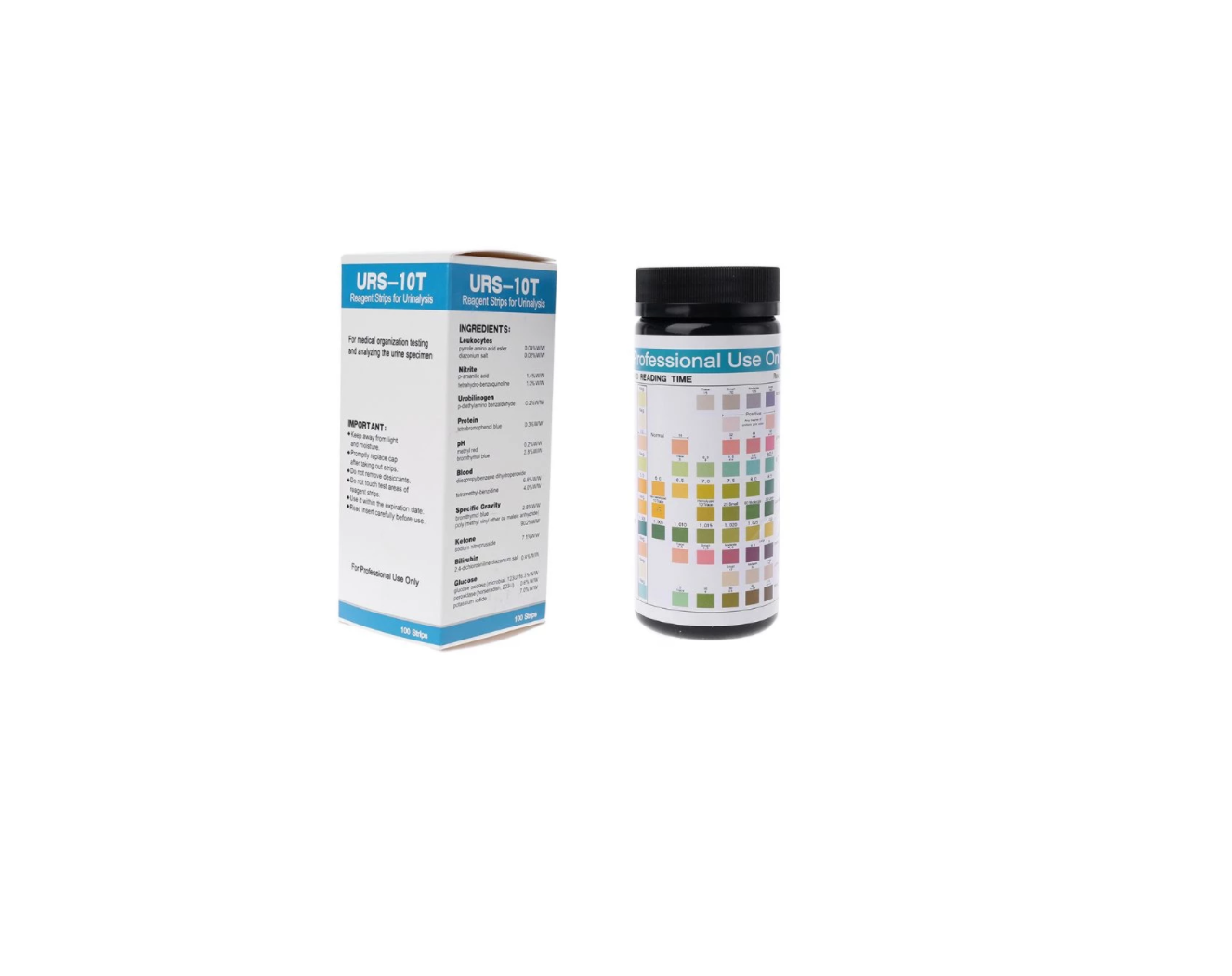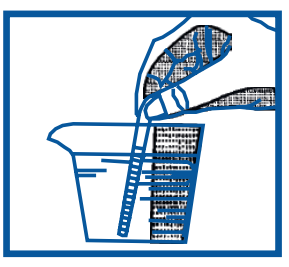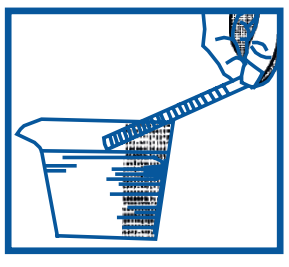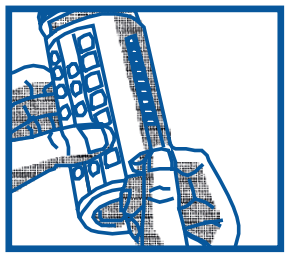GIMA URS-10T Urinalysis Reagent Strips Instructions
SUMMARY AND INTENDED USE
The content of the instruction include usage, reaction principle, and notification.URS series Reagent strips are intended for qualitative and semi-quantitative urinalysis and for in vitro diagnostics use.The strips are for professional use only.The strips may be read visually or instrumentally. Please read the instruction carefully before use.There are the test items of every products type.
| Products Type | Test Item |
| URS 13 | Urobilinogen, Bilirubin, Ketone (acetoacetic acid), Blood, Protein, Nitrite, Leukocytes, Glucose, Specific Gravity, pH, Ascorbic Acid, Microalbumin, Creatinine |
| URS 12, URS 11,URS 10, URS 9,URS 8, URS 7, URS 6,URS 5, URS 4, URS 3,URS 2, URS 1 | The items of product type from URS 2 to URS 12 can be conbined randomly from URS 13 test items mentioned above.US1 item can be any item from URS 13. |
SPECIMEN COLLECTION AND PREPARATION
Collect fresh urine in a clean dry container. Use uncentrifuged urine and mix the sample before testing. The sample should not be more than 2 hours old at the time of testing. Always handle specimens under sanitary conditions.Note: Water should not be used as negative control. Preservatives will not prevent the deterioration of ketones, bilirubin or urobilinogen. Bacterial growth from contaminating organisms may affect glucose, pH, nitrite and blood test results.
VISUAL READING TECHNIQUE
- Immerse all reagent areas in specimen and remove strip immediately.

- Run edge of strip against the rim of the container to remove excess urine.

- Hold strip horizontally and compare test areas closely with colour chart on bottle label. Record the results.
 For a semi-quantitative result read the reagent areas at the time specified on the colour chart. The pH and Protein areas may also be read immediately or at any time up to 60 seconds after dipping. For a qualitative result read the reagent areas between 1 and 2 minutes. If a positive result is obtained, repeat the test, reading each reagent at the time specified on the colour chart. Colour changes after 2 minutes are of no diagnostic value.
For a semi-quantitative result read the reagent areas at the time specified on the colour chart. The pH and Protein areas may also be read immediately or at any time up to 60 seconds after dipping. For a qualitative result read the reagent areas between 1 and 2 minutes. If a positive result is obtained, repeat the test, reading each reagent at the time specified on the colour chart. Colour changes after 2 minutes are of no diagnostic value.
INSTRUMENT READING TECHNIQUE
Follow the directions given in the appropriate instrument-operating manual
STORAGE AND HANDLING PROCEDURES
Store only in original bottle. Do not use after expiry date. Every strip can be used only once. Do not remove desiccant(s). Do not remove strip from the bottle until immediately before it is to be used for testing. Replace cap immediately and tightly after removing reagent strip.Store at temperatures between 2℃-30℃.Don’t store in refrigerator. Keep away from direct sunlight.Do not touch test areas of reagent strips. PROTECTION AGAINST AMBIENT MOISTURE, LIGHT AND HEAT IS ESSENTIAL TO GUARD AGAINST ALTERED REAGENT REACTIVITY. Deterioration may result in discoloration or darkening of the reagent areas. If this is evident or if test results are questionable or inconsistent with expected results, confirm that strips are within the expiry dates and compare with control urine. Please deal with the waste strips according to “Treatment Regulations of Lab Biohazard Materials”. Once the canister has been opened,the remaining strips are stable for up to 3 months in humidity conditions lower than 65%RH.
LIMITATIONS OF PROCEDURES
As with all laboratory tests, definitive diagnostic or therapeutic decisions should not be made or based on any single result or method.
TEST PRINCIPLES
GLUCOSE: One enzyme, glucose oxidize catalyzes the formation of gluconic acid and hydrogen peroxide from the oxidation of glucose. Hydrogen peroxide releases neo-ecotypes oxide [O] under the function of peroxidase, [O] oxidates potassium iodides chromogen, so that it makes the color change.BILIRUBIN: This test is based on coupling the direct bilirubin with diazotized dichloroaniline in a strongly acid medium, which produce the diazotizing colors.KETONE: This test is based on that acetoacetate acid react with sodium nitroprusside in an alkaline medium, producing violet color.SPECIFIC GRAVITY: Electrolyte (M+X-) in the form of salt in urine reacts with poly (methyl vinyl ether/maleic omhydride (-COOH ), which is weakly acid ionic exchanger. And then hydrogenous ion is replaced from it and reacts with pH indicator in order to make the color change.BLOOD: This test is based on the peroxidase activity of hemoglobin and myoglobin, which makes peroxide release neo-ecotypic oxide[O]. Indicator is oxidized by [O] and shows color change subsequently.PH: This test is based on a double indicator principle.PROTEIN: The test is based on the protein-error-of-indicators principle. Anion on the specific pH indicator is absorbed by cation on protein molecule, which make the indicator ionize and present color change at critical point of color.NITRITE: This test d epends u pon th e ni trite dia zotizewith aromatic amino sulphanilamide to form a diazonium compound. This diazonium compound in turn couples with 1,2,3,4-tetrahydro benzo(h)quinolin-3-phenol to produce a pink color.LEUCOCYTES: Granulocytic leukocytes in urine contain esterases that catalyze the hydrolysis of the privatized pyrrole amino acid ester to liberate 3-hydroxy-5-pheny pyrrole. This pyrrole then reacts with a diazonium salt to form a purple color.ASCORBIC ACID: Ascorbic acid, with 1,2-dihydroxy alkenes, under alkaline condition, deoxidizes blue 2,6- dichloroindophenolate form into colorless N-(P-phenol)- 2,6-dichloro–P- amine phenol,.MICROALBUMIN: Based on the protein deviation method, utilizing the sulfonephthalein dyestuff only specific to Microalbumin.CREATININE: Creatinine can act with 3, 5-di nitro benzoic acid in strong alkalinity, generating colored compound.
Note:GLUCOSE: The test is specific for glucose, no substance excreted in urine other than glucose is known to give a positive result. In dilute urine containing less than 0.28mmol/L ascorbic acid, as little as 2.2 mmol/L glucose may produce a colour change that might be interpreted as positive. Ascorbic acid concentrations of 2.8mmol/L or greater and/or high acetoacetic concentrations (1.0mmol/L) may influence test. Small amounts of glucose may normally be excreted by the kidney.These amounts are usually below the sensitivity of this test.BILIRUBIN: Normally no bilirubin is detectable in urine by even the most sensitive methods. Even trace amounts of bilirubin are sufficiently abnormal to require further investigation. Medicines that color the urine red or that are themselves red in an acid medium, e.g., phenazopyridine may influence the test. Large ascorbic acid concentration may cause false negatives.KETONE: The test reacts with acetoacetic acid in urine. It does not react with acetone or β-hydroxbutyric acid.Normal urine specimens usually yield negative results with this reagent. False positive results may occur with highly pigmented urine specimens or those containing large amounts or levodopa metabolites.SPECIFIC GRAVITY: The specific gravity permits determination of urine specific gravity between 1.000 and 1.030.In general, it correlates within 0.005 with values obtained with the refractive index method. For increased accuracy, 0.005 may be added to readings from urines with pH equal to or greater than 6.5. Strips read instrumentally are automatically adjusted for pH by the instrument. The SG test is not affected by certain nonionic urine constituents such as glucose or by the presence of radiopaque dye. Highly buffered alkaline urines may cause low readings relative to other methods. Elevated specific gravity readings may be obtained in the presence of moderate quantities (1-7.5g/L) of protein.BLOOD: The significance of the ‘Trace’ reaction may vary among patients, and clinical judgment is required for assessment in an individual case. Development of green spots (intact erythrocytes) or green colour (free haemoglobin/ myoglobin) on the reagent area within 60 seconds indicates the need for further investigation.Blood is often found in the urine of menstruating females. Haemoglobin concentration of 150-620μg/L is approximately equivalent to 5- 15/μL intact red blood cells per microlitre.This test is highly sensitive to haemolobin and thus complements the microscopic examination. The sensitivity of this test may be reduced in urines with high specific gravity. This test is equally sensitive to myoglobin as to haemoglobin. Certain oxidizing contaminants, such as hypochlorite, may produce false positive results.Microbial peroxidase associated with urinary tract infection may cause a false positive reaction. Levels of 2.8mmol/L ascorbic acid normally found in urine do not interfere with this test.PH: The pH test area measures pH values generally to within 1 unit in the range of 5.0-8.5 visually and 5.0-9.0 instrumentally.PROTEIN and MICROALBUMIN:The Protein reagent area can detect albumin in urine and has low sensitivity to mucoprotein, generaly up to 0.6g/L concentration.The Microalbumin reagent area is to detect the microalbumin. Beyond 0.15 g/L indicate albuminuria clinically. The Microalbumin reagent can detect specificly microalbumin, and 9 times more sensitive than other protein. Visible blood urine (≥0.05g/L) can be false negative action.UROBILINOGEN: This test area will detect urobilinogen in concentrations as low as 3μmol/L (approximately 0.2 Ehrlich unit/dL) in urine. The normal range with this test is 3-16μmol/L. a result of 33 μmol/L represents the transition from normal to abnormal, and the patient and/or urine specimen should be evaluated further. The absence of urobilinogen cannot be determined with this test.
NITRITE: This test depends upon the conversion of nitrate (derived from the diet) to nitrite by the action of principally Gram-negative bacteria in the urine. The test is specific for nitrite and will not react with any other substance normally excreted in urine. Pink spots or pink edges should not be interpreted as a positive result Any degree of uniform pink colour development should be interpreted as a positive nitrite test suggesting the presence of 105 or more organisms per mL, but colourdevelopment is not proportional to the number of bacteria present. A negative result does not prove that there is no significant bacteriuria. Negative results may occur.
- when urinary tract infections are caused by organisms which do not contain reductase to convert nitrate to nitrite;
- when urine has not been retained in the bladder long enough( four hours or more) for reduction of nitrate to occur,
- or when dietary nitrate is absent. Sensitivity of the nitrite test is reduced for urines with high specific gravity. It may resist 2.8mmol/L Ascorbic Acid.
LEUKOCYTES: Test area react with esterase in leucocytes (granulocytic leukocytes). Normal urine specimens generally yield negative result; positive results (+ or greater) are clinically significant. Individually observed ‘Trace’ results may be of questionable clinical significance; however ‘Trace’ results observed repeatedly may be clinically significant. ‘Positive’ results may occasionally be found with random specimens from females due to contamination of the specimen by vaginal discharge. Elevated glucose concentrations (160mmol/L) or high specific gravity may cause decreased test results
ASCORBIC ACID: The test area can detect the ascorbic acid in urine. Through the ascorbic acid detection, we will know the level of ascorbic acid in the body and the effect degree that the ascorbic acid bring to the test on glucose, bilirubin, blood and nitrite. It will reduce the sensitivity when the oxidant (such as potassium permanganate, hypochlorite ) in the urine.
CREATININE: Adult normal urine creatinine is 0.6-2.0g/24 hour (the Creatinine reagent area results is about 50-200mg/dL) . Result of random urine sample differ largely, from 10mg/dl to 300mg/dl. Concentrated urine and morning urine have high concentration (possibly over 200mg/dl). Because of diuresis, excessive drinking water, or other urine dilution, resulting in testing anlyte concentration decrease (result can be less than 50mg/dl).
SPECIFIC PERFORMANCE CHARACTERISTICS:
Specific performance characteristics are based on clinical and analytical studies. In clinical specimens, the sensitivity depends upon several factors; the variability of colour perception, the presence or absence of inhibitory factors typically found in urine, specific gravity, pH, and the lighting conditions when the product is read visually. Each colour block or instrumental display value represents a range of values. Because of specimen and reading variability, specimens with analyte concentrations that fall between nominal levels may give results at either level. Results at levels greater than the second positive level for the Protein, Glucose, Ketone, and Urobilinogen tests will usually be within one level of the true concentration. Exact agreement between visual results and instrumental results might not be found because of the inherent differences between the perception of the human eye and the optical system of the instruments.
Sensitivity and test range of urinalysis strips
|
Rem |
Sensitivity | Instrumental test range |
Visual testrange |
|
Glucose (mmol/L) |
2.8-5.5 | Neg-55 |
Neg-110 |
|
Protein (g/L) |
0.15-0.3 | Neg -3.0 |
Neg — 20.0 |
|
Microalbumin (g/L) |
0.08-0.15 |
0-0.15 |
|
|
Ketone (acetoacetic acid) (mmol/L) |
0.5-1.0 | Neg-7.8 |
Neg-16 |
|
Blood (Ery/uL) |
5-15 |
Neg. 200 |
|
|
Bilirubin(pmol /L) |
3.3-8.6 |
Neg.-100 |
|
|
Nitrite (pmol /L) |
13-22 |
Neg. or Pos. |
|
|
Leukocytes (cells/pL) |
5-15 |
Neg. – 500 |
|
|
Urobilinogen (pmol /L) |
3.3-16 |
3.3-131 |
|
|
Ascorbic acid (mmoUL) |
0.3-0.6 |
0-5.0 |
|
|
Creatinine(mg/dL) |
25-75 |
10-300 |
|
|
pH |
— |
5.0-8.5 |
|
|
Specific Gravity |
— | 1.005-1.030 I |
1.000-1.030 |
REACTIVE INGREDIENTS
(based on dry weight at time of impregnation)PROTEIN: 0.1% m/m tetrabromphenol blue; 97.4% w/w buffer; 2.5% w/w nonreactive ingredientsBLOOD: 26.0% w/w diisopropylbenzene dihydro peroxide; 1.5% w/w tetramethyl-benzidine; 35.3% w/w buffer; 37.2%nonreactive in gredients.GLUCOSE: 1.7% w/w glucose oxidase (microbial.123U); 0.2 % w/w peroxidase(horseradish. 203 IU); 0.1% w/w potassium iodide; 71.8% w/w buffer; 26.2% w/w nonreactive ingredients.KETONE: 5.7% w/w sodium nitroprusside; 29.9% w/w nonreactive ingredients;64.4% w/w buffer;LEUCOCYTES: 4.3% w/w pyrrole amino acid ester; 0.4% w/w diazonium salt; 92.6% w/w buffer; 2.7% w/w nonreactive ingredients.
NITRITE: 1.3% w/w p-arsanilicacid; 0.9% N-(1-Naphthol) ethylenediamine; 89.6%w/w buffer; 8.2% w/w nonreactive ingredients.SPECIFIC GRAVITY: 4.8% w/w bromthymol blue; 90.2% w/w poly(methyl vinyl ether co maleic anhydride); 5.0% w/w sodium hydroxide. PH: 3.3% w/w bromcresol green; 55.0% w/w bromthymol blue; 41.7%w/w nonreactive ingredients.BILIRUBIN: 0.6% w/w 2.4-dichlorbenzene amine diazonium salt; 57.3% w/w buffer; 42.1% w/w nonreactive ingredients.UROBILINOGEN: 0.2% w/w p-di ethylamino benzaldehyde 98.0% w/w buffer; 1.8% w/w nonreactive ingredients.ASCORBIC ACID: 0.8% w/w 2,6-dichloroindophenolate hydrate; 40.7% w/w buffer; 58.5% w/w nonreactive ingredients.MICROALBUMIN: 2.2% w/w sulfonephthalein dyestuff; 96.0% w/w buffer; 1.8 w/w nonreactive ingredients.CREATININE: 4.8% w/w 3, 5-2 nitro benzoic acid; 85.2% w/w buffer; 10% w/w nonreactive ingredients.
GIMA WARRANTY TERMSThe Gima 12-month standard B2B warranty applies.
|
Product code |
|
|
|
Consult instructions for use |
|
|
Expiration date |
|
|
Manufacture |
|
|
In vitro diagnostic medical device compliant with Directive 98/79 / EC |
|
|
Date of manufacture |
|
Lot number |
|
|
|
Temperature limit |
|
|
In vitro diagnostic medical device |
| Disposable device, do not re-use | |
|
|
Authorized representative in the European community |
![]()
![]()
![]()
![]()
![]()
![]()
Importado por:Gima S.p.A. Via Marconi, 1 – 20060 Gessate (MI) Italy[email protected] – [email protected]www.gimaitaly.com
![]()
![]()
![]()
![]()
![]()
![]()
![]()






References
[xyz-ips snippet=”download-snippet”]




 For a semi-quantitative result read the reagent areas at the time specified on the colour chart. The pH and Protein areas may also be read immediately or at any time up to 60 seconds after dipping. For a qualitative result read the reagent areas between 1 and 2 minutes. If a positive result is obtained, repeat the test, reading each reagent at the time specified on the colour chart. Colour changes after 2 minutes are of no diagnostic value.
For a semi-quantitative result read the reagent areas at the time specified on the colour chart. The pH and Protein areas may also be read immediately or at any time up to 60 seconds after dipping. For a qualitative result read the reagent areas between 1 and 2 minutes. If a positive result is obtained, repeat the test, reading each reagent at the time specified on the colour chart. Colour changes after 2 minutes are of no diagnostic value.